

 Share This Page
Share This Page| Home | | Sailing | | Alaska 2011 | |  |  |  Share This Page Share This Page |

Copyright © 2011, P. Lutus. All rights reserved. Message Page
| Prior years: |
Alaska 2002 |
Alaska 2003 |
Alaska 2004 |
Alaska 2005 |
Alaska 2006 Alaska 2007 | Alaska 2008 | Alaska 2009 | Alaska 2010 |
(double-click any word to see its definition)
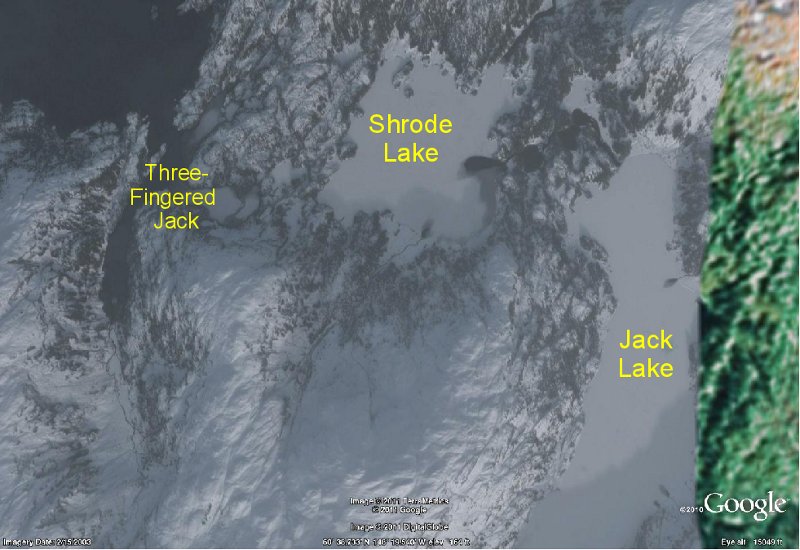
Figure 2: Overview of boat anchorage, Shrode and Jack Lakes (Google Earth)
Note: Don't be misled by the snow cover in Figures 2 and 3 — the satellite images were taken in in February.
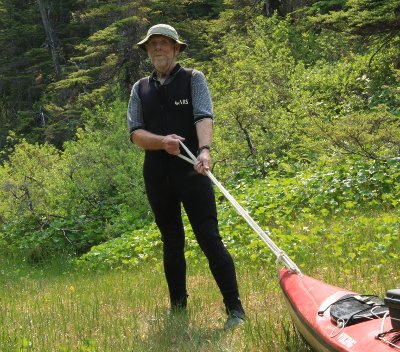
Author abusing a nice, lightweight Kevlar kayak
For many years I've visited a small bay called "Three-Fingered Bay", southeast of Whittier in Prince William Sound, anchored there, then dragged my kayak from the anchorage to Shrode Lake (about 1/2 mile through small lakes and mostly grassy terrain), to explore a pretty wilderness environment, rarely visited by humans.
I should explain that, along with visiting bear country and not being eaten, this is one of my favorite Alaska activities: I anchor my boat near a fresh-water lake, paddle to shore, and drag my kayak through the brush to the lake, in order to explore a new place. At the best locations, the terrain is a mixture of grassland, ponds and small lakes, so the effort of moving the kayak is not overwhelming. At the worst locations, the ground is rocky and dry, which is hard on both me and the boat. But the Shrode Lake drag route is one of the best — it's a series of grassy meadows and little lakes, relatively easy. There are only a few short, steep uphill drags.
During prior visits to Shrode Lake, I knew there was another lake farther east named Jack Lake that I have always wanted to see, but because of typically poor weather conditions and laziness I had never been willing to drag my kayak that far ... until this season.
I mentioned earlier that the weather had been especially rainy, but on July 5 the sun came out early and the wind diminished, very good signs. I had planned to visit Shrode Lake, but I decided if the conditions remained favorable and I was feeling energetic, I might try for Jack Lake.
During the off season I had (virtually) explored the region with Google Earth, to see if there was an efficient way to drag a boat between Shrode and Jack lakes. Though the satellite pictures of this area aren't very good, I saw small secondary lakes between Shrode and Jack, and a possible drag route from the south end of one small lake to another near the shore of Jack Lake. I made a mental note.
Then, while in the field, once I got to Shrode Lake, because of the nice weather I decided to carry on and explore the territory to the east. Remarkably, my time spent looking at satellite images turned out the be a perfect rehearsal for the real thing (details below), and I was able to get to Jack Lake without mishap.
As I put my kayak into Jack Lake, the wind died completely and the last clouds evaporated. Because of the absence of wind and because of the purity of this unspoiled lake (see Figure 1), I was able to see to a depth of about 30 feet with perfect clarity, which is one of my favorite kayaking experiences (as you paddle, you feel as though you're flying over a mysterious green world).
During a few hours of windless, sunny weather, I slowly paddled the entire lake, admiring the surrounding snowcapped peaks (Figure 1), and pretending I had been transported to an earlier time, before cities, cars and airplanes. Because of the absence of wind and the remote location, there was no sound. It was a wonderful, essentially ideal experience at an ideal location. It's not too much to say, even though I've paddled kayaks all over the world, this was my most perfect paddle. (At this point Homer Simpson would say, "Your most perfect paddle so far!")
Some may think dragging a kayak across the land is more work than simply walking unladen — isn't this just a way to burn calories? Well, actually, no — in environments like that described above, a mixture of lakes and ponds joined by stretches of land, you can't get very far without some kind of boat, and paddling across a pond is way less work than walking the same distance in typical Alaska brush. It's a matter of choosing the right kayak (mine is Kevlar and only weighs 38 pounds) and not carrying too much gear.
It turns out there's a hiking trail between Three-Fingered Bay (the salt water anchorage) and Shrode Lake (along a different route than I take), and it's a classic of its kind. It was apparently designed by a committee, and everybody got what they wanted. It's one of the worst trails I have ever seen, constantly and pointlessly climbing and descending, with many signs of well-intentioned but misguided trail work, like log staircases that nature quickly dismantles and turns into efficient barriers to reasonable progress. Years ago, as I hiked the trail, it occurred to me that it would be way more efficient to drag my kayak across the land using a more direct route — and this turned out to be so.
The Gory Details
I don't normally describe a route in such detail, but this location has some peculiarities and risks that merit description. The waypoints described below are shown above in Figure 3, and here are the waypoints as a GPX file.
Phase 1 — Boat anchorage to Shrode Lake (about 1/2 mile)
Phase 2 — Shrode Lake to Jack Lake (about 1/3 mile)
When I venture onto the land in a location like this, I carry water, bear spray and a trail saw to cut brush. And a camera, of course. Here are some more pictures of this beautiful area:
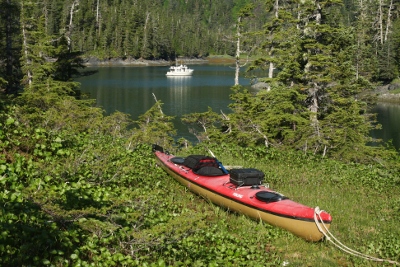
Near waypoint 1, the salt water end of the trail
(my boat Teacup is in the background) |
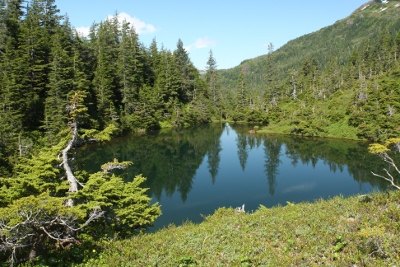
The little lake between waypoints 10 and 11
|
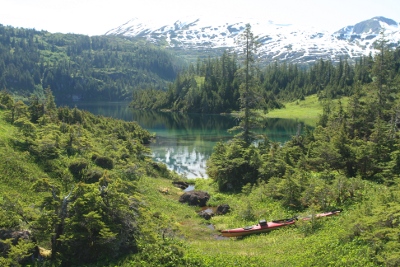
At the shore of Jack Lake (waypoint 12)
|
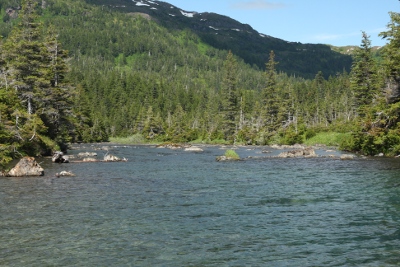
The exit stream at waypoint 14 (avoid this route)
|
| Home | | Sailing | | Alaska 2011 | |  |  |  Share This Page Share This Page |